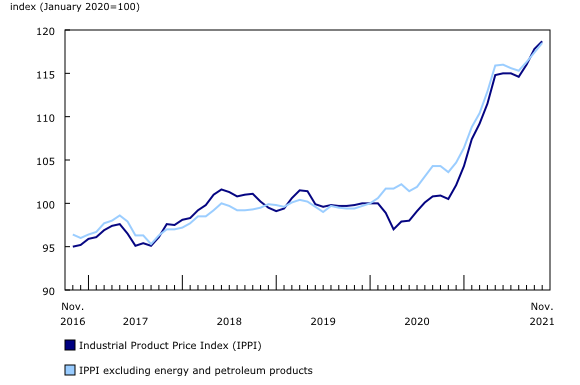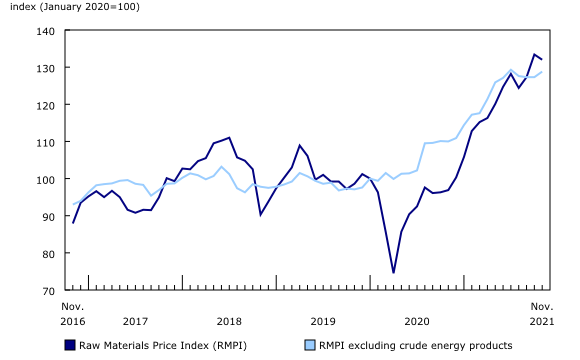Industrial product and raw materials price indexes, November 2021
Archived Content
Information identified as archived is provided for reference, research or recordkeeping purposes. It is not subject to the Government of Canada Web Standards and has not been altered or updated since it was archived. Please "contact us" to request a format other than those available.
Released: 2022-01-04
The price of products manufactured in Canada, as measured by the Industrial Product Price Index (IPPI), increased 0.8% month over month in November and 18.1% compared with the same period in 2020. Prices of raw materials purchased by manufacturers operating in Canada, as measured by the Raw Materials Price Index (RMPI), fell 1.0% month over month in November, and were up 36.2% year over year.
Industrial Product Price Index
In November, the IPPI was up by 0.8% on a monthly basis, and 18.1% year over year.
Prices for ammonia and chemical fertilizers rose 10.5% compared with October 2021, a seventh consecutive monthly increase. This put prices 132.7% higher than November 2020, making it the largest year-over-year increase on record for ammonia and chemical fertilizers. Globally, prices for fertilizer have been pushed up by a multitude of factors. Higher prices for inputs used in fertilizer production, including natural gas and coal, are playing a part. Fertilizer exports have been restricted in China, where production was recently affected by a shortage of coal. Russia has also placed quotas on exports of fertilizer, a move that was signalled in November and took effect as of December 2021. In 2019, China and Russia were the top two exporters of fertilizer, accounting for 24.7% of global exports.
Many intermediate food products showed price gains in November. Prices for flour and other grain mill products were up 2.3% on a monthly basis, and were 40.9% higher than November 2020. The grain and oilseed products, n.e.c. category rose 7.3% month over month, and 26.8% year over year. This category includes canola oil, as well as soybean oil and soybean meal. Canola oil prices have been trending upward due to tight canola supply in Canada. Soybean meal prices spiked in November in part due to a shortage of dry lysine, an additive for animal feed. Soybean meal can be substituted in its place.
From October to November, the Canadian dollar depreciated by 1.1% on average against the US greenback. This increases the nominal prices of goods priced in US dollars. Prices for motorized and recreational vehicles rose by 0.6% in November, mostly attributable to this depreciation. If the exchange rate was held constant during calculations, this commodity group would have risen by 0.3%, and the overall IPPI would have gained 0.4% instead of 0.7%.
Prices for energy and petroleum products fell 0.7% month over month, coinciding with a drop in prices for crude oil. Diesel and biodiesel fuels (-3.0%), and motor gasoline (-1.0%) both posted lower prices in November. Crude prices fell sharply in late November due to demand concerns associated with the Omicron COVID-19 variant.
Prices for the unwrought gold, silver, and platinum metals group rose 3.9% on a monthly basis in November, following five consecutive months of decline. The increase may be in part attributable to hedging against inflation and its effect on the real rate of return.
The price of unwrought aluminum and aluminum alloys fell 8.5% from October to November. This followed six consecutive months of increases. The decline was partly attributable to China ramping up imports of coal, the main energy source for their aluminum industry.
Factory gate prices of key meat products were mixed in November. The price of fresh and frozen pork was down 9.1% on a monthly basis and down 7.5% year over year. This coincided with a 10.5% monthly decline for hogs. Canadian stocks of frozen and chilled pork in cold storage were up 3.7% year over year at the beginning of the fourth quarter of 2021; this was 13.1% higher than the level at the beginning of the third quarter. China's pork imports were down 50.1% year over year in November, as domestic production increased and the population of hogs recovered from the impact of African swine fever.
Prices for fresh and frozen beef and veal were up 4.6% on a monthly basis and 22.9% higher than in November 2020. This coincided with a 2.3% monthly gain in the price of cattle, putting it 15.9% higher year over year. Stocks of frozen and chilled beef in cold storage were down 5.8% on a monthly basis at the beginning of the fourth quarter of 2021, and were 4.2% lower than the beginning of the third quarter. Strong seasonal demand going into the holiday period also played a role in the price increase.
Raw Materials Price Index
The RMPI fell by 1.0% month over month in November, and was up 36.2% year over year.
Prices for crude energy products fell by 4.4% on a monthly basis. Excluding crude energy products, the RMPI was up by 1.2% month over month.
In November, prices for coal fell 32.8% as China augmented its production in response to tight supply and high prices. Year over year, coal prices were up 135.3%. The price of natural gas was down 4.5% from October to November, partly due to higher than expected temperatures in the United States. Conventional crude oil prices fell 2.7%, as demand concerns due to the Omicron COVID-19 variant reduced optimism.
Many crop products posted higher monthly prices, including canola (+8.7%) and wheat (+8.5%). The increases continue a trend brought on by limited supply. Recent field crop estimates show that Canadian production of canola fell by 35.4% in 2021, while wheat production fell by 38.5%.
Prices for iron ores and concentrates fell 20.4%, as limited steel production in China kept demand low.
Prices for hogs (-10.5%) fell in November, coinciding with ample cold storage of pork in Canada going into the fourth quarter, and increased production in China. Conversely, cattle posted a 2.3% monthly gain, in part due to strong seasonal demand, and lower stocks of frozen beef going into the fourth quarter.
Note to readers
The Industrial Product Price Index (IPPI) and the Raw Materials Price Index (RMPI) are available at the Canada level only. Selected commodity groups within the IPPI are also available by region.
With each release, data for the previous six months may have been revised. The indexes are not seasonally adjusted.
The Industrial Product Price Index reflects the prices that producers in Canada receive as goods leave the plant gate. The IPPI does not reflect what the consumer pays. Unlike the Consumer Price Index, the IPPI excludes indirect taxes and all costs that occur between the time a good leaves the plant and the time the final user takes possession of the good. This includes transportation, wholesale and retail costs.
Canadian producers export many goods. They often indicate their prices in foreign currencies, especially in US dollars, and these prices are then converted into Canadian dollars. This is particularly the case for motor vehicles, pulp and paper products, and wood products. Therefore, fluctuations in the value of the Canadian dollar against its US counterpart affect the IPPI. However, the conversion to Canadian dollars reflects only how respondents provide their prices. This is not a measure that takes into account the full effect of exchange rates.
The conversion of prices received in US dollars is based on the average monthly exchange rate established by the Bank of Canada and available in Table 33-10-0163-01 (series v111666275). Monthly and annual variations in the exchange rate, as described in the release, are calculated according to the indirect quotation of the exchange rate (for example, CAN$1 = US$X).
The Raw Materials Price Index reflects the prices paid by Canadian manufacturers for key raw materials. Many of those prices are set on the world market. However, as few prices are denominated in foreign currencies, their conversion into Canadian dollars has only a minor effect on the calculation of the RMPI.
Discontinuation of IPPI flash estimates
The IPPI flash estimates, which have been published since March 2020, will no longer be released as of January 2022. The last release was on December 14, 2021, with the publication of the November 2021 flash estimates.
The monthly release of the industrial product and raw materials price indexes will soon be published earlier each month, effective with the release of February 2022 data on March 22, 2022.
Products
Statistics Canada launched the Producer price indexes portal as part of a suite of portals for prices and price indexes. This web page provides Canadians with a single point of access to a variety of statistics and measures related to producer prices.
The video "Producer price indexes" is available on the Statistics Canada Training Institute web page. It provides an introduction to Statistics Canada's producer price indexes—what they are, how they are made, and what they are used for.
Next release
The industrial product and raw materials price indexes for December 2021 will be released on January 31, 2022.
Contact information
For more information, or to enquire about the concepts, methods or data quality of this release, contact us (toll-free 1-800-263-1136; 514-283-8300; infostats@statcan.gc.ca) or Media Relations (statcan.mediahotline-ligneinfomedias.statcan@statcan.gc.ca).
- Date modified:





